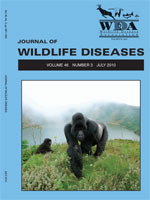The dusky-footed woodrat (Neotoma fuscipes) is the putative reservoir for Anaplasma phagocytophilum in the western United States based on high prevalence of A. phagocytophilum genetic material detected by polymerase chain reaction (PCR), high antibody prevalence, and infestation with the vector tick Ixodes pacificus. Following inoculation of nine wild-caught woodrats with woodrat-, canine-, or equine-origin A. phagocytophilum, all became PCR-positive and seroconverted. However, when PCR-positive woodrat blood was delivered as inoculum to three horses, the horses never became clinically ill, PCR-positive, or antibody-positive. Each horse was subsequently infected with either the equine- or chipmunk-origin A. phagocytophilum, resulting in clinical anaplasmosis. Our data show that woodrats are permissive to several strains of A. phagocytophilum, but strains originating from woodrats did not cause clinical disease in horses.
How to translate text using browser tools
1 July 2010
THE DUSKY-FOOTED WOODRAT (NEOTOMA FUSCIPES) IS SUSCEPTIBLE TO INFECTION BY ANAPLASMA PHAGOCYTOPHILUM ORIGINATING FROM WOODRATS, HORSES, AND DOGS
Nathan C. Nieto,
John E. Madigan,
Janet E. Foley
ACCESS THE FULL ARTICLE

Journal of Wildlife Diseases
Vol. 46 • No. 3
July 2010
Vol. 46 • No. 3
July 2010
dusky-footed woodrat
granulocytic anaplasmosis
host-tropism
Ixodes pacificus
Neotoma fuscipes
sylvatic reservoir
tick-borne disease




